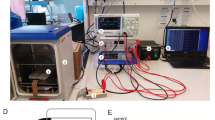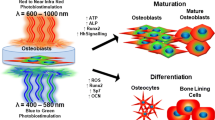Abstract
Electrotherapy for bone healing, remodeling and wound healing may be mediated by modulation of nitric oxide (NO). Using NO-specific fluorophore (DAF-2), we report here that application of non-invasive, physiologic electrical stimulation induces NO synthesis in human osteoblasts, and that such NO generation is comparable to that induced by estrogen treatment. For example, application of a sinusoidal 1 Hz, 2 V/cm (peak to peak) electrical stimulation (ES) increases NO-bound DAF-2 fluorescence intensity by a 2-fold within 60 min exposure by activating nitric oxide synthase (NOS). Increase in the NO level is found to depend critically on the frequency and strength of ES. While the frequency of 1 Hz ES seems optimal, the ES strength >0.5 V/cm is required to induce significant NO increase, however. Nitric oxide synthesis in response to ES is completely prevented by blocking estrogen receptors using a competitive inhibitor, suggesting that NO generation is likely initiated by activation of estrogen receptors at the cell surface. Based on these findings, physiologic stimulation of electrotherapy appears to represent a potential non-invasive, non-genomic, and novel physical technique that could be used to regulate NO-mediated bone density and facilitate bone remodeling without adverse effects associated with hormone therapy.






Similar content being viewed by others
REFERENCES
Aaron R. K., Ciombor D. M., Simon B. J. 2004 Treatment of nonunion with electric and electromagnetic fields Clin. Orthoped. 419:21–29
Ashcroft G. S., Mills S. J., Lei K., Gibbons L., Jeong M. J., Taniguchi M., Burow M., Horan M. A., Wahl S. M., Nakayama T. 2003 Estrogen modulates cutaneous wound healing by downregulating macrophage migration inhibitory factor J. Clin. Invest. 111(9):1309–1318
Brighton C. T. 1981 The treatment of nonunions with electricity J. Bone Joint Surg. Am. 3A:847–851
Brighton C. T., Sharma P., Heppenstall R. B., Esterhai J. L., Pollack S. R., Friedenberg Z. B. 1995 Tibial nonunion treated with direct current, capacitive coupling, or bone graft Clin. Orthoped. 321:223–234
Brighton C. T., Wang W., Seldes R., Zhang G., Pollack S. R. 2001 Signal transduction in electrically stimulated bone cells J. Bone Joint Surg. Am. 83A(10):1514–1523
Calabrese V., Boyd-Kimball D., Scapagnini G., Butterfield D. A. 2004 Nitric oxide and cellular stress response in brain aging and neurodegenerative disorders: the role of vitagenes In Vivo 18(3):245–267
Cho M. R. 2002 A review of electrocoupling mechanisms mediating facilitated wound healing IEEE Trans. Plasma Sci. 30:1504–1515
Cho M. R., Thatte H. S., Lee R. C., Golan D. E. 1994 Induced redistribution of cell surface receptors by alternating current electric fields FASEB J. 8:771–776
Cho M. R., Thatte H. S., Lee R. C., Golan D. E. 2000 Integrin-dependent human macrophage migration induced by oscillatory electrical stimulation Ann. Biomed. Eng. 28(3):234–243
Cho M. R., Thatte H. S., Lee R. C., Golan D. E. 1996 Reorganization of microfilament structure induced by ac electric fields FASEB J. 10:1552–1558
Cho M. R., Marler J. P., Thatte H. S., Golan D. E. 2002 Control of calcium entry in human fibroblasts by frequency-dependent electrical stimulation Frontiers Biosci. 7:1–8
Compston J. E. 2001 Sex steroids and bone Physiol. Rev. 81(1):419–447
Contreras J. L., Smyth C. A., Bilbao G., Young C. J., Thompson J. A., Eckhoff D. E. 2002 17β-Estradiol protects isolated human pancreatic islets against proinflammatory cytokine-induced cell death: molecular mechanisms and islet functionality Transplantation 74(9):1252–1259
Cushman M., Kuller L. H., Prentice R., Rodabough R. J., Psaty B. M., Stafford R. S., Sidney S., Rosendaal F. R. 2004 Women’s health initiative investigators. Estrogen plus progestin and risk of venous thrombosis JAMA 292(13):1573–1580
Cutolo M., Capellino S., Montagna P., Villaggio B., Sulli A., Seriolo B., Straub R. H. 2003 New roles for estrogens in rheumatoid arthritis Clin. Exp. Rheumatol. 21(6):687–690
Daff S. 2003 Calmodulin-dependent regulation of mammalian nitric oxide synthase Biochem. Soc. Trans. 31:502–505
Das U. N. 2002 Nitric oxide as the mediator of the antiosteoporotic actions of estrogen, statins, and essential fatty acids Exp. Biol. Med. 227:88–93
Diniz P., Soejima K., Ito G. 2002 Nitric oxide mediates the effects of pulsed electromagnetic field stimulation on the osteoblast proliferation and differentiation Nitric Oxide 7(1):18–23
Evans D. M., Ralston S. H. 1996 Nitric oxide and bone J. Bone Miner. Res. 11:300–305
Giugni T. D., Braslau D. L., Haigler H. T. 1987 Electric field-induced redistribution and postfield relaxation of epidermal growth factors on A431 cells J. Cell Biol. 104:1291–1297
Goetz R. M., Thatte H. S., Prabhakar P., Cho M. R., Michel T., Golan D. E. 1999 Estradiol induces the calcium-dependent translocation of endothelial nitric oxide synthase Proc. Natl. Acad. Sci. USA 96:2788–1793
Grunkemeier, J., C. Wan, and T. Horbet. Changes in binding affinity of a monoclonal antibody to a platelet binding domain of fibrinogen adsorbed to biomaterials. J. Biomater. Sci. Polym. (8th ed.), 1996, pp. 189–209
Ignarro L. J. 1989 Endothelium-derived nitric oxide: actions and properties. FASEB J. 3(1):31–36
Isenberg J. S. 2004 Nitric oxide modulation of early angiogenesis Microsurgery 24(5):385–391
Ishida H., Hirota Y., Higashijima N., Ishiwata K., Chokoh G., Matsuyama S., Murakami E., Nakazawa H. 2004 Direct nitric oxide release from nipradilol in human coronary arterial smooth muscle cells observed with fluorescent NO probe and NO-electrode Pathophysiology 11(2):77–80
Khatib, L., D. E. Golan, and M. R. Cho. Physiologic electrical stimulation provokes calcium increase mediated by phospholipase C activation in human osteoblasts. FASEB J. doi:10.1096/fj.04-1814fje, 2004
Kondo T., Kobayashi K., Murohara T. 2004 Nitric oxide signaling during myocardial angiogenesis Mol. Cell Biochem. 264(1–2):25–34
Kone B. C. 2000 Protein–protein interactions controlling nitric oxide synthases Acta. Physiol. Scan. 168:27–31
Kone B. C., Kuncewicz T., Zhang W., Yu Z. Y. 2003 Protein interactions with nitric oxide synthases: controlling the right time, the right place, and the right amount of nitric oxide Am. J. Physiol. Renal Physiol. 285:178–190
Lauffenburger D. A., Linderman J. J. 1993 Receptors: Models for Binding, Trafficking, and Signaling. Oxford University Press, New York, NY, USA
Lindsay R. 2004 Hormones and bone health in postmenopausal women. Endocrine 24(3):223–230
Lin S. K., Kok S. H., Kuo M. Y., Lee M. S., Wang C. C., Lan W. H., Hsiao M., Goldring S. R., Hong C. Y. 2003 Nitric oxide promotes infectious bone resorption by enhancing cytokine-stimulated interstitial collagenase synthesis in osteoblasts J. Bone Miner. Res. 18(1):39–46
McAllister T. N., Frangos J. A. 1999 Steady and transient fluid shear stress stimulates NO release in osteoblasts through distinct biochemical pathways J. Bone Miner. Res. 14(6):930–936
McLaughlin S., Poo M. M. 1981 The role of electro-osmosis in the electric field-induced movement of charged macromolecules of the surfaces of cells Biophys. J. 34:85–93
Min K. R., Shin H. M., Lee J. H., Kim B. H., Chung E. Y., Jung S. H., Kim Y. 2004 Anti-inflammatory effects of N1-benzyl-4-methylbenzene-1,2-diamine (JSH-21) analogs on nitric oxide production and nuclear factor-kappa B transcriptional activity in lipopolysaccharide-stimulated macrophages RAW 264.7 Arch. Pharm. Res. 27(10):1053–1059
Miyamoto M., Sato E. F., Nishikawa M., Nishizawa Y., Morii H., Inoue M. 2003 Effect of endogenously generated nitric oxide on the energy metabolism of peritoneal macrophages Physiol. Chem. Phys. Med. NMR 35(1):1–11
Ortiz N. D. A., Mengchun L. G., Hernandez M. I., Mendoza R., Ayala R. 2004 Absence of antiosteopenic effect of hormone replacement therapy in postmenopausal women Ginecol. Obstet. Mex. 72:349–355
Poo M. M. 1981 In situ electrophoresis of membrane components Ann. Rev. Biophys. Bioeng. 10:245–276
Pietras R.J., Szego C. M. 1977 Specific binding sites for estrogen at the outer surfaces of isolated endometrial cells Nature 265:69–72
Prabkahar P., Thatte H. S., Goetz R. M., Cho M. R., Golan D. E., Michel T. 1998 Receptor-regulated translocation of endothelial nitric oxide synthase J. Biol. Chem. 273:27383–27388
Practice Committee of the American Society for Reproductive Medicine. 2004 Estrogen and progestogen therapy in postmenopausal women Fertil. Steril. 82(1):S70–S80
Prevention, management of osteoporosis. 2003 World health organ Tech. Rep. Ser. 921:1–164
Pritsch O., Clergeon G. H., Buckle M., Pétillot Y., Bouvet J. P., Gagnon J., Dighiero G. 1996 Can Immunoglobulin CH1 constant region domain modulate antigen binding affinity of antibodies? J. Clin. Invest. 98:2235–2243
Reher P., Harris M., Whiteman M., Hai H. K., Meghji S. 2002 Ultrasound stimulates nitric oxide and prostaglandin E2 production by human osteoblasts Bone 31(1):236–241
Rosenfeld R. J., Garcin E. D., Panda K., Andersson G., Aberg A., Wallace A. V., Morris G. M., Olson A. J., Stuehr D. J., Tainer J., Getzoff E. D. 2002 Conformational changes in nitric oxide synthases induced by chlorzoxazone and nitroindazoles: crystallographic and computational analyses of inhibitor potency Biochemistry 26:13915–13925
Schmidt K., Mayer B. 2004 Consumption of nitric oxide by endothelial cells: evidence for the involvement of a NAD(P)H-, flavin- and heme-dependent dioxygenase reaction FEBS Lett. 577(1–2):199–204
Schuh K., Uldrijan S., Telkamp M., Rothlein N., Neyses L. 2001 The plasmamembrane calmodulin-dependent calcium pump: a major regulator of nitric oxide synthase I. J. Cell Biol. 155(2):201–205
Somboonporn W., Davis S. R. 2004 Postmenopausal testosterone therapy and breast cancer risk Maturitas 49(4):267–275
Staren E. D., Omer S. 2004 Hormone replacement therapy in postmenopausal women Am. J. Surg. 188(2):136–149
Tank D. W., Fredericks W. J., Barak L. S., Webb W. W. 1985 Electric field-induced redistribution of postfield relaxation of low density lipoprotein receptors on cultured human fibroblasts J. Cell Biol. 101:148–157
Titushkin I., Rao V., Cho M. R. 2004 Mode- and cell-type dependent calcium responses induced by electrical stimulus IEEE Trans. Plasma Sci. 32:1614–1619
Wehling M. 1997 Specific nongenomic actions of steroid hormones Ann. Rev. Physiol. 59:365–393
Witte M. B., Barbul A. 2002 Role of nitric oxide in wound repair Am. J. Surg. 183:406–412
Yoshida M., Xia Y. 2003 Heat shock protein 90 as an endogenous protein enhancer of inducible nitric-oxide synthase J. Biol. Chem. 278(38):36953–36958
Zheng X., Ning G., Hong D., Zhang M. 2004 Nitric oxide imaging in neurons using confocal microscopy Methods Mol. Biol. 279:69–80
Zhuang D., Ceacareanu A. C., Lin Y., Ceacareanu B., Dixit M., Chapman K. E., Waters C. M., Rao G. N., Hassid A. 2004 Nitric oxide attenuates insulin- or IGF-I-stimulated aortic smooth muscle cell motility by decreasing H2O2 levels: essential role of cGMP Am. J. Physiol. Heart Cir. Physiol. 286(6):H2103–H2112
ACKNOWLEDGMENTS
This work was supported by NIH grants (GM060741, EB006067), and by the Office of Naval Research grants (N00014-03-1-0329, N00014-06-1-0100).
Author information
Authors and Affiliations
Corresponding author
Rights and permissions
About this article
Cite this article
Hamed, A., Kim, P. & Cho, M. Synthesis of Nitric Oxide in Human Osteoblasts in Response to Physiologic Stimulation of Electrotherapy. Ann Biomed Eng 34, 1908–1916 (2006). https://doi.org/10.1007/s10439-006-9206-5
Received:
Accepted:
Published:
Issue Date:
DOI: https://doi.org/10.1007/s10439-006-9206-5




